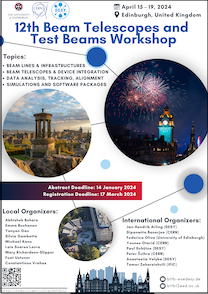Speaker
Description
The RD51 collaboration focuses on the R&D of Micro-Pattern Gaseous Detectors (MPGDs). Included in their activities are joint test beam campaigns at a semi-permanent facility at the H4 beam line of CERN’s Super Proton Synchrotron (SPS). As part of the test beam infrastructure, two beam telescopes with 10 x 10 cm² active area are provided. One telescope employs MicroMegas detectors for tracking and the other one uses Gas Electron Multipliers (GEM). Both of them are read out with the RD51 Scalable Readout System (SRS), with two options for the front-end ASICs: the APV25 and the more recent ATLAS/BNL VMM3a. This allows to read out up to 5k channels with typically around 500 to 1000 channels per detector.
The results presented here have been obtained with the GEM telescope (around 50 µm spatial resolution) that is combined with scintillators and Photomultiplier-Tubes (PMTs) for timing (around 1 ns time resolution). It is read out, including the NIM-logic connected to the PMTs, with the VMM3a. With the front-end electronics providing also the charge information, a simultaneous detector characterisation in energy, space and time is possible. Due to the continuous self-triggered readout scheme, particle interaction rates up to the MHz regime can be recorded.
Following the successful commissioning of the beam telescope in the last years, in this presentation, the latest improvements and detector characterisation results will be shown. On the telescope’s side, the main focus was the development of a new powering scheme for the front-end electronics, enabling in particular the use of a telescope lever arm of around 20 m. The detector studies focussed on characterising GEMs with higher-granularity amplification structures, showing that they improve the detector’s spatial resolution. In addition, the results from characterising a prototype GEM detector for the AMBER experiment and resistive MPGDs with a single amplification stage (µRWELL and MicroMegas) will be presented.
With the RD51 collaboration ceasing operation end of 2023 and being succeeded by the DRD1 collaboration, the telescopes will be used in the future for the DRD1 test beam campaigns. This includes continuing the improvements of the telescopes, e.g. by the ongoing implementation of externally triggered readout modes for the VMM3a front-end.
